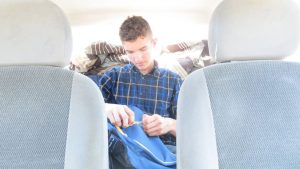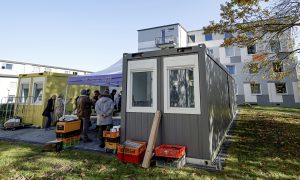When it comes to college, “getting in is only half the battle,” according to Anthony Abraham Jack, professor at the Harvard School of Education.
Elsewhere he has said: “Before all else, colleges must meet students’ basic needs.”
Unfortunately, the nation’s largest annual student assessment of basic needs security, the Hope Center for College, Community and Justice’s 2020 #RealCollege Survey, reveals that 48% of college students struggle with housing insecurity, and a full 14% of students are homeless. Lacking adequate housing or food is the No. 1 barrier to college completion.
 Desperate to help its homeless students, Long Beach City College in California initiated the Safe Parking Program, which provides unhoused students a safe and secure place to sleep in their cars. Although a lifeline for the 15 students who receive spaces in the school’s parking deck, the Safe Parking Program alone can do little to alleviate the problem at a college where 1,000 students are unhoused and 3,000 students are housing insecure.
Desperate to help its homeless students, Long Beach City College in California initiated the Safe Parking Program, which provides unhoused students a safe and secure place to sleep in their cars. Although a lifeline for the 15 students who receive spaces in the school’s parking deck, the Safe Parking Program alone can do little to alleviate the problem at a college where 1,000 students are unhoused and 3,000 students are housing insecure.
“We’re losing students — human beings with hopes and dreams that are being derailed,” said Michael Munoz, superintendent president. Now in its second year, the program not only provides Wi-Fi, restrooms and showers for students living in their cars, but also car insurance, driver’s licensing and registration to make sure students don’t lose what “homes” they have.
“Homeless college student seems like a contradiction in terms,” according to Wayne State University psychology professor Paul Toro. “If you’re someone who has the wherewithal to get yourself into college, well, of course you should be immune to homelessness. But that just isn’t the case.”
Rising costs and choices to be made
That’s because attending college in the United States has become exponentially more expensive over the past few decades. The average price of college room and board has doubled since 1994. Adjusted for inflation, average tuition at four-year public universities was 355.1% higher in 2020 than it was in 1963.
Both are set to rise again by as much as 5% in the coming year as schools adjust for the high price of food and fuel. These exorbitant costs make affording college more challenging for everyone, but it’s an even “greater challenge for students that come from families that are struggling,” admitted David Jewell, vice president for business affairs at Cleveland State University.
If a student or their family cannot afford both tuition and room and board, then housing (and often food) is sacrificed.

College student Colin Ashby lived in his car his freshman year at Texas State University. (Via ABC News)
Education has the potential to lift families out of poverty; but without secure housing, college students are less likely to realize that potential because they are more likely to suffer from depression, anxiety, and poorer health, the national research found.
“We like to think that landing a coveted college spot is a golden ticket for students from disadvantaged backgrounds. We think less critically about what happens next,” Jack said in the New York Times Magazine. Students of color, indigenous students, LGBTQ students (especially trans students), those who are first generation, and students who receive low-income Pell grants are all at greater risk for housing insecurity and would benefit from on campus housing.
Not enough housing
The heart of the problem is that there simply is not enough on-campus housing to meet the demand, and most residence halls are filled on a first-come, first-served basis. Students who have the resources to apply and commit early receive the rooms. Those who need more financial aid than the college offers, or who need additional time to work to raise the money they need, get left out. They find themselves on waitlists along with hundreds of other students at the start of the semester. Some give up and look for housing elsewhere. Others give up on college altogether.

A homeless man gathers up debris at People’s Park in Berkeley, Calif., Tuesday, Aug. 16, 2022. The three-acre site’s colorful history, forged from University of California, Berkeley’s seizure of the land in 1968, has been thrust back into the spotlight by the school’s renewed effort to pave over People’s Park as part of a $312 million project that includes sorely needed housing for about 1,000 students. (AP Photo/Eric Risberg)
Many colleges are actively trying to build more housing; but doing so takes time and resources and often is complicated by politics on and off campus. In Berkley, Calif., attempts to build more affordable student housing have been met with protests by area residents who want to preserve a university-owned park. These protests have stalled construction of a new dorm that would provide 1,100 units for low-income students and an additional 100 units for the city’s unhoused.
They way in which many colleges and universities are going about building new housing also is problematic. More and more, schools are turning to private sector companies not only to build but also to run their campus housing. These developers are looking to maximize their returns and therefore promote the building of more profitable luxury housing. But these “premium residence halls” come with premium price tags.
Prioritizing amenities over affordability leaves students who cannot afford these more expensive luxury dorms without options during a time of housing scarcity.
In Philadelphia, “they want to take away Section 8 housing to make way for more upscale college apartments — that doesn’t solve the problem (of affordable housing) for either situation,” according to Chaplain and Director for Religious Life at Elizabethtown College Amy Shorner-Johnson speaking to BNG.
And creating separate university housing for the “haves” and “have-nots” further widens the socioeconomic divide within the school.
The problem with off-campus housing
Off-campus housing is traditionally a more affordable alternative for college students, but a decrease in available units coupled with an increase in rent is closing that door too. After the housing collapse of 2008, construction of multi-family units plummeted to levels not seen since the 1960s, leaving the current housing market with 3.8 million fewer homes to rent or buy.

In 2021, University of California at Santa Barbara student James Estrada looked for housing near his campus for two weeks but had no luck. He lived in q sprinter van instead.
The Great Recession also left 10 million foreclosed homes in its wake. Some were converted into Airbnbs and removed from the long-term rental market. Millions more were scooped up by large private equity firms which now own such a significant percent of the market that they can essentially raise rents at will. The rise of these landlord oligarchies, coupled with a greatly reduced housing stock, leaves students with few affordable options and increasingly no options at all.
As imposing as these market forces are for all low-income renters, students face additional barriers. Near the UC Irvine campus, landlords currently require student applicants to list a guarantor who earns four times the monthly rent.
“It’s an absurd metric which weeds out a lot of marginalized, underprivileged students,” sociology major Adriana Lugo told the Los Angeles Times.
Bad timing for Pell grants
Many low-income students also depend on their financial aid packages for security deposits. However, federal rules prevent Pell grants from being issued earlier than 10 days before classes start. That left the 6.2 million students who were awarded grants in 2020-2021 scrambling for housing less than two weeks before school started.
Current funding rules fail students in other ways too. The total cost of attendance at a university determines the amount of funding a student receives. This total is comprised of direct costs like tuition and fees, plus indirect costs such as books, transportation and housing. Because there is no set standard for calculating indirect costs, school administrators make what they consider to be reasonable guesses. Unfortunately, these guesses have not kept up with the realities of rising costs.
Indirect cost estimates are consistently off by as much as $3,000 for two-year colleges when compared to the MIT Living Wage Calculator. This difference means students are not receiving financial aid commiserate with their actual housing expenses, leaving one in five community college students in California housing insecure.
Some low-income students are eligible for the government’s Housing Choice Voucher Program (also known as Section 8) if they are enrolled full time. However, if a student receives non-tuition grants to help with the cost of textbooks, a laptop, fees or even housing, those grants are counted as income, which can then put that student over the qualifying income limit. But even with a voucher, many local public housing developments refuse to accept student applications.
“You get less support from the government when you’re a student then when you’re not.”
“You get less support from the government when you’re a student than when you’re not,” said Sara Goldrick-Rab, founder of the Hope Center at Temple University.
Finding solutions
Fortunately, some colleges and communities are finding ways to help.
Colleges in Colorado are adjusting the timing of housing deposits to better coincide with dispersal of students’ financial aid.
In Tacoma, Wash., community colleges partnered with the local housing authority to create the Tacoma Housing Assistance Program, which provides housing vouchers to full-time students who are housing insecure. So great is the need, however, there’s currently a six month wait for vouchers.
Tacoma also created the Collegiate Homesharing Program, matching students with residents who have rooms to rent. The program provides a screening service, conducts interviews and arranges background checks.
Even programs not directly focused on housing can reduce students’ expenditures, thereby freeing up money for rent. City University in New York provides free textbooks, tuition and metro cards for students who qualify. As of 2021, more than 700 universities had food pantries on campus and many have added seasonal free farmers’ markets. The nonprofit Swipe Out Hunger helps students at 450 colleges donate their unused meal credits to students who are food insecure.
What you and your church can do
Much more needs to be done. Individuals and organizations interested in helping students afford housing can lobby Congress to revise Section 8 rules that classify educational grants as income, so students aren’t forced to choose between financial aid and housing. They also can advocate for funding at the state level to build university housing focused on affordability as well as rental caps like the bill that created California’s Higher Education Student Housing Grant. Alumni could encourage their alma maters to take the guesswork out of indirect cost estimates and use HUD’s Fair Market Rent data instead.
Churches can get involved as well. All who follow Jesus have a mandate to care for the marginalized. Low-income students, students of color, indigenous students, those who are immigrants or undocumented, students with dependents, foreign students far from home, and LGBTQ students are all more likely to be unhoused or at risk of losing their housing. Churches can help students in their area by providing access to food and other necessities. Period poverty is an especially unspoken hardship faced by menstruating students who are unhoused and one that often goes unaddressed.
Mt. Olive Lutheran Church in California repurposed unused classrooms to create a homeless shelter for students and now provides beds, showers, laundry facilities and meals for 10 students from area colleges. The “Students 4 Students Shelter” was the idea of Louis Tse, a UCLA student who wanted to help his unhoused peers. After 50 houses of worship turned him down, Mt. Olive said “yes.”
“There are currently 200 students on a waiting list for a bed at the student run shelter.”
“It’s what we should do based on God’s love for all people,” said pastor Eric Shafer. There are currently 200 students on a waiting list for a bed at the student run shelter.
Students also need short-term housing during winter break and spring break when dorms and cafeterias are closed, forcing a growing number of students into housing and food insecurity. “Colleges take for granted … what students can afford,” Anthony Jack explained in his TED Talk. “What if you can’t afford to go home? Or what if you don’t have a home to go to? Or what about, if for you, “hurt” and “home” are synonymous?”

In the German state of Schleswig-Holstein, shipping containers have been converted to tiny houses on the grounds of a university Student Union as a short-term solution for student homelessness. (Photo by: Axel Heimken/picture-alliance/dpa/AP Images)
At Elizabethtown College, Amy Shorner-Johnson believes students need “soft places to land during breaks.”
Of course, what these students really need is adequate, accessible and affordable housing. One reason homelessness among college students persists and continues to grow is that these college students tend to be invisible.
“They don’t look like the homeless population we’re used to seeing,” Shafer said. “They couch-surf and take showers at the school gym.”
That’s why bringing the problem into the light is so very important. The more attention the student housing crisis receives, the sooner students’ needs can be met. And that needs to happen, for the good of us all.
College students need to “use their smarts on their books, not on finding a safe place to sleep every night,” said Students 4 Students founder Louis Tse. “There is immense human talent we are leaving on the table. You might be helping a future MacArthur ‘genius grant’ award winner, someone who’s majoring in the same field you studied, or someone who might save a life, maybe even yours or mine.”
Kristen Thomason is a freelance writer with a background in media studies and production. She has worked with national and international religious organizations and for public television. Currently based in Scotland, she has lived in Metro D.C. and Toronto, Canada. In addition to writing for Baptist News Global, Kristen blogs on matters of faith and social justice at viaexmachina.com.
Related articles:
On social media, the Bible verses are flying in a debate over student loan forgiveness | Analysis by Mark Wingfield


